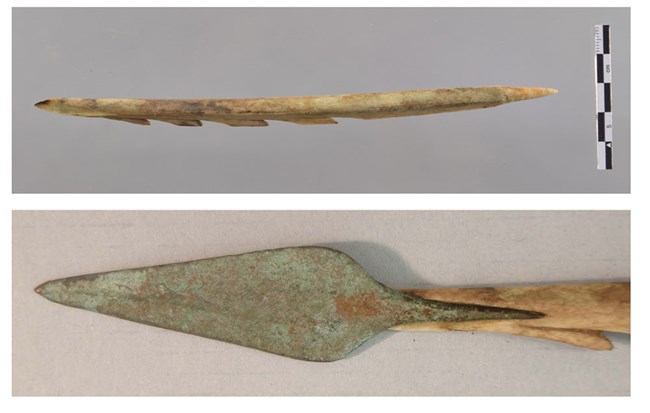Last updated: December 4, 2024
Article
Bone and Copper Arrows Found in Melting Ice Patches

As alpine ice patches melt, they reveal archaeological artifacts. Ice-patch sites in Alaska and the Canadian Yukon are known to have a hunting history dating back 9,400 years. Ice-patch research, as well as oral history, has helped us understand the evolution of ancient hunting technology--the tools and materials used in prehistoric times to modern era.
Arrow points found at the Bonanza ice patch in Wrangell-St. Elias National Park, and at the Texas Gulch and Deuces Wild ice patchs in the Yukon, were of antler with copper blades, likely used for big game hunting, and used at the time of early European contact (around fur trading). Projectile points, knives, and awls are the most common types of copper tools found at archaeological sites and exhibit quite a bit of variation.
The current study used a technique called X-ray fluorescence (XRF) to ascertain the presence of copper residue on antler points found without blades, demonstrating that the lost end-blades were indeed manufactured from copper. A key observation of this study is that composite arrow points using end-blades were a common armature in the tool kit, using not only copper end-blades, but end-blades of antler, bone, and likely chipped stone. To date, three Alaskan and eight Yukon bone arrowheads have been recovered from ice patches that show end-blading was a common functional element of point design prior to the colonial period. Before the discoveries documented in this article, only two end-blades had been found in direct association with bone or antler arrow points.
Ice patches help preserve artifacts in place with little disturbance or degradation. The recovery of artifacts from melting ice patches can show us how people designed, crafted, and assembled tools in ancient times.
Yukon First Nation use of Copper for End-Blades on Hunting Arrows
Abstract
Copper metallurgy and bow and arrow technology are widely considered hallmark traits of the Late Prehistoric Period in the northwest of North America (Yukon and Alaska). In recent years, a number of osseous arrow points have been recovered from melting alpine ice patches in the northwest, some with evidence of copper utilization. This article reports on the construction and radiocarbon dating of three osseous arrowheads recovered from Yukon-Alaska ice patches and documents the use of handheld energy-dispersive x-ray florescence (EDXRF) technology to discriminate native copper implements, as well as detect absorbed copper residues from other osseous points. We also reference several other bladed arrow points discovered at ice patches in Yukon and neighboring Alaska to develop a tentative timeline for the use of copper end-blades with osseous arrow points in the northwest.
Thomas, C. D., P. G. Hare, J. D. Reuther, J. S. Rogers, H. K. Cooper, and E. J. Dixon. 2020. Yukon First Nation use of copper for end-blades on hunting arrows. Journal of Glacial Archaeology (2016):109-131.
